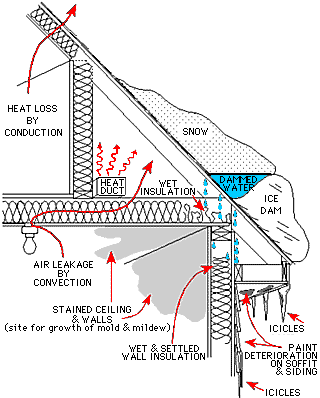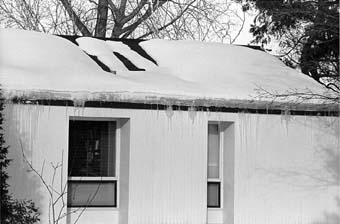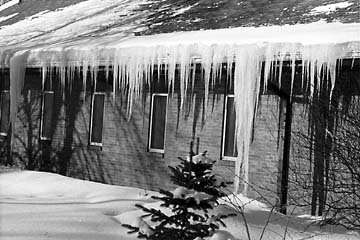ICE DAMS
Ice damming is a major source of water damage to many homes....
ROOF ICE BUILD-UP
Sometimes known as ice dams, these giant icicles hanging from the eaves are not only dangerous to people walking underneath, they are often a sign of serious problems with the roof and/or in the attic.
In a well designed and constructed home, the attic has its own dry and cool environment, quite separate from the living space. If your attic is not isolated from the rest of the house with proper air sealing and insulation, it can become warm and moist. Warm attics can help melt the bottom layer of snow on the roof and the water runs down to the gutter where it refreezes. This is the beginning of an ice dam.
HOW DOES MOISTURE GET INTO THE ATTIC?
There are several sources, both exterior and interior. If the roof is old and leaking, obviously that is an exterior source. But lets talk about interior sources that are often overlooked, but are not too difficult to correct.
Interior sources include air leaks from the house into the attic. Moisture is carried by air movement from the warm home into the cold attic, where the moisture in the air condenses and wets cold surfaces, such as the roof sheathing and rafters. Over time, chronic moisture causes mold and mildew.
PLUG THE AIR LEAKS TO STOP THE MOISTURE.
The largest "holes" leading directly from the house to the attic are the attic access and the whole house fan.
When an attic access is a fold-down stairway, it was difficult to control moisture and heat loss. The Battic Door Attic Stair Cover is a low-cost, easy-to-install solution to this common problem.
When a whole house fan is installed in the home, it was difficult to control moisture and heat loss. The Battic Door Whole House Fan Cover and Battic Door Whole House Fan Shutter Seal provide two low-cost, easy-to-install solutions to this common problem.
Form the experts at University of Minnesota:
What is an ice dam?
An ice dam is a ridge of ice that forms at the edge of a roof and prevents melting snow (water) from draining off the roof. The water that backs up behind the dam can leak into a home and cause damage to walls, ceilings, insulation, and other areas. Figure 1 shows a cross section of a home with an ice dam.

Figure 1. Cross section of a one-and-a-half story house with an ice dam.
What causes ice dams?
There is a complex interaction among the amount of heat loss from a house, snow cover, and outside temperatures that leads to ice dam formation. For ice dams to form there must be snow on the roof, and, at the same time, higher portions of the roof's outside surface must be above 32° F while lower surfaces are below 32°F. For a portion of the roof to be below 32°F, outside temperatures must also be below 32°F. When we say temperatures above or below 32°F, we are talking about average temperature over sustained periods of time.
The snow on a roof surface that is above 32°F will melt. As water flows down the roof it reaches the portion of the roof that is below 32°F and freezes. Voila!—an ice dam.
The dam grows as it is fed by the melting snow above it, but it will limit itself to the portions of the roof that are on the average below 32°F. So the water above backs up behind the ice dam and remains a liquid. This water finds cracks and openings in the exterior roof covering and flows into the attic space. From the attic it could flow into exterior walls or through the ceiling insulation and stain the ceiling finish.
Nonuniform roof surface temperatures lead to ice dams.
What causes different roof surface temperatures?
Since most ice dams form at the edge of the roof, there is obviously a heat source warming the roof elsewhere. This heat is primarily coming from the house. In rare instances solar heat gain may cause these temperature differences.
Heat from the house travels to the roof surface in three ways: conduction, convection, and radiation. Conduction is heat energy traveling through a solid. A good example of this is the heating of a cast iron frying pan. The heat moves from the bottom of the pan to the handle by conduction.
If you put your hand above the frying pan, heat will reach it by the other two methods. The air right above the frying pan is heated and rises. The rising air carries heat/energy to your hand. This is heat transfer by convection. In addition, heat is transferred from the hot pan to your hand by electromagnetic waves and this is called radiation. Another example of radiation is to stand outside on a bright sunny day and feel the heat from the sun. This heat is transferred from the sun to you by radiation.
In a house, heat moves through the ceiling and insulation by conduction through the slanted portion of the ceiling (Figure 1). In many homes, there is little space in regions like this for insulation, so it is important to use insulations with high R-value per inch to reduce heat loss by conduction.
The top surface of the insulation is warmer than the other surroundings in the attic. Therefore, the air just above the insulation is heated and rises, carrying heat by convection to the roof. The higher temperatures in the insulation's top surface compared to the roof sheathing transfers heat outward by radiation. These two modes of heat transfer can be reduced by adding insulation. This will make the top surface temperature of the insulation closer to surrounding attic temperatures directly affecting convection and radiation from this surface.
There is another type of convection that transfers heat to the attic space and warms the roof. In Figure 1, the winding arrow beginning inside the house and going through the penetration in the ceiling, from the light to the attic space, illustrates heat loss by air leakage. In many homes this is the major mode of heat transfer that leads to the formation of ice dams.
Exhaust systems like those in the kitchen or bathroom that terminate just above the roof may also contribute to snow melting. These exhaust systems may have to be moved or extended in areas of high snow fall.
Other sources of heat in the attic space include chimneys. Frequent use of wood stoves and fireplaces allow heat to be transferred from the chimney into the attic space. Inadequately insulated or leaky duct work in the attic space will also be a source of heat. The same can be said about kneewall spaces.
Photograph 1 shows a single story house with an ice dam. The points of heat loss can be clearly seen as those areas with no snow. The ceiling below this area needs to be examined for air leakage (often through an attic stair and/or whole house fan), missing or inadequate insulation, leaky or poorly insulated ductwork, and the termination of a kitchen or bathroom exhaust into the attic space.

Photograph 1. A single-story house with an ice dam. The areas without snow are the points of heat loss.
Photograph 2 illustrates unusually high heat loss from the roof. There is very little snow left on the roof and at its edge is both an ice dam and a "beautiful" row of icicles.

Photograph 2. The unusually high heat loss on this roof has caused both an ice dam and icicles.
So it is primarily heat flowing from the house that is causing the nonuniform temperatures of the roof surface leading to ice dams.
Here are several documents written by Zerodraft (an expert and manufacturer of sealants and foams) that describe other sources of air leaks.

Here is a recent article written by Mark Tyrol, Owner of Battic Door, and published Nationwide!
Got Attic Mold? Lets Talk Energy Conservation!
By Mark D. Tyrol, P.E., Battic Door Energy Conservation Products
It happens to countless homeowners around the end of the year – you make the annual visit to your attic to collect the holiday decorations and what do you find? Spots and blotches covering the bottom of the roof sheathing. Worse yet – it turns out to be attic mold!
What does energy conservation have to do with mold in the attic? Well if you take a step back and consider how the house behaves as system, they are often directly related.
Building science experts have long been using the “house as a system” approach to diagnose the cause and origin of building defects.
For example, ice dams. These are often caused by warm air seeping into the attic which causes the snow and ice on the roof to melt. The water drains to the edge of the roof (which is colder than the rest of the roof because it is an overhang and not warmed by the attic), freezes and creates an ice dam. As this process is repeated daily, the ice dam grows larger. Eventually water is forced under a shingle where it can seep into the house.
Understanding how the house behaves as a system and the various causes and effects is necessary to diagnose most building related problems.
But how about that attic mold? How did it get there?
Mold requires chronic moisture to form and to thrive, so source(s) of moisture must be present. Possibly the moisture came from outdoors. The roof is newer and a quick check of the roof shows no obvious damage or leaks.
Possibly the moisture came from indoors. During the heating season, the interior of the house frequently has high moisture levels, especially bathrooms and kitchens. A quick check shows that all bathroom fans, kitchen vents, etc. are properly ducted completely outdoors and not into the attic. The amount of insulation looks good and the attic is well ventilated.
Don’t give up – you are almost there! Remember the house as a system? You know that warm, moist air is in the house, but how is it getting into the attic?
By air leaks! Air leaks are the leading source of energy loss in most houses, and a frequent source of chronic moisture that can cause attic mold. Most homeowners are well aware of air leaks around windows and doors (especially old ones), but many overlook the numerous gaps leading directly into the attic!
Have a look around the attic and you may find large gaps around recessed lights and fans, holes where wires or pipes are installed, even large gaps around the chimney. And don’t overlook the whole house fan and especially the folding attic stair - a big, uninsulated hole in your ceiling that is often overlooked!
These gaps can add up to a large hole that allows warm, moist air from the house to flow right into the cold attic. The warm moist air condenses on the cold roof sheathing, creating chronically damp conditions that can lead to attic mold growth. And the energy loss – it can be like leaving a window open all winter long!
Seal these air leaks and you stop a significant moisture source. And just think of all the energy you can save and the cold drafts you can stop!
Mark D. Tyrol is a Professional Engineer specializing in cause and origin of construction defects. He developed several residential energy conservation products including an attic stair cover and attic access door, and is the US distributor of the fireplace draftstopper. To learn more visit www.batticdoor.com |